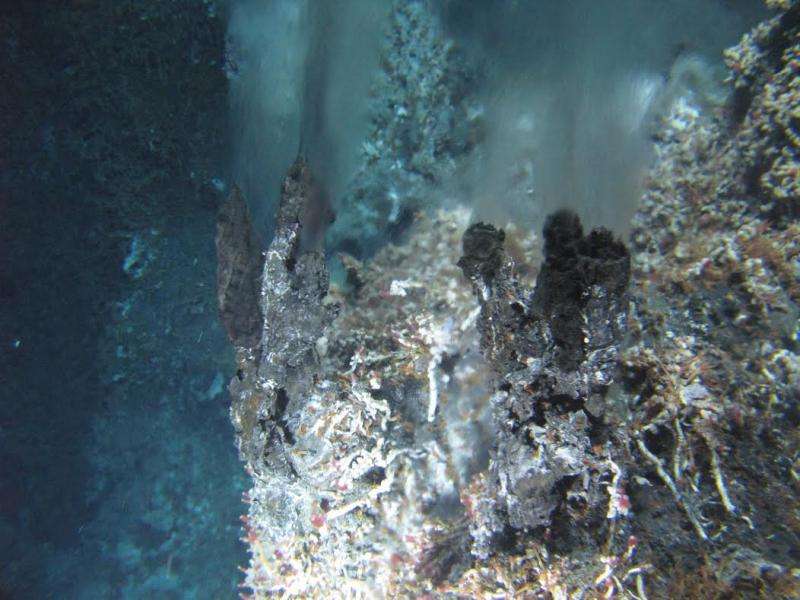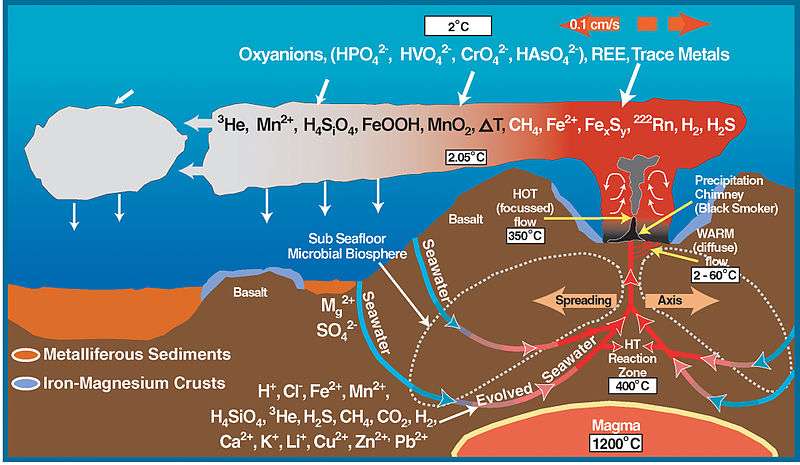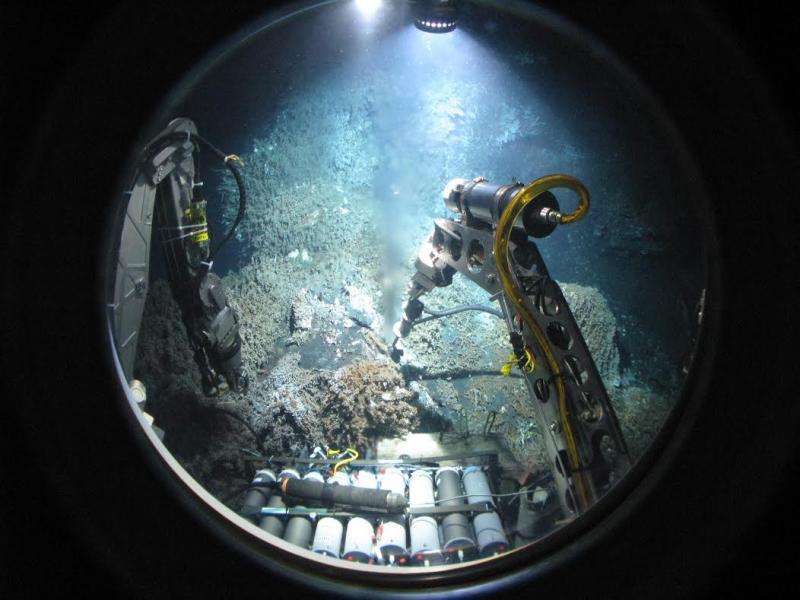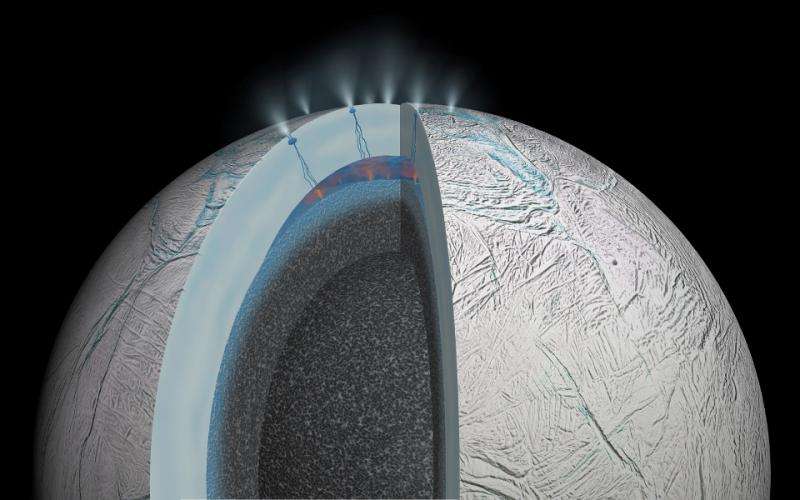Viruses help microbial hosts cope with life at the extremes

A new study reveals that viruses lend a surprisingly helpful hand to microbes eking out a living near deep-sea hydrothermal vents.
When they infect the vent's resident bacteria and archaea, the viruses mix and match the single-celled creatures' genes. As a result, the microbes can benefit from possessing a wide range of genes in a way that broadens their repertoire of responses to the quick-changing, harsh conditions of the vent environment.
The findings, published in PLOS ONE in October 2014, could offer insight into the development of life on Earth as well as on Solar System moons, such as Saturn's Enceladus and Jupiter's Europa, which both have suspected hydrothermal vent activity in their subsurface oceans.
"Viruses can affect the evolution of the hosts they infect, and in unexpected ways," said study lead author Rika Anderson, a Postdoctoral Program Fellow with the NASA Astrobiology Institute, and at the time of the study a doctoral student at the University of Washington.
"Around these hydrothermal vents, the viruses might let their cellular hosts adapt to the environment when the environment changes."
Lightless, scalding, freezing, acidic, basic
Hydrothermal vents are cracks in the ocean floor where water rushes in and is superheated by subsurface magma. By any measure, they're tough places to live. Hydrothermal vents receive no sunlight and have crushing water pressures, sometimes hundreds of times the weight of the atmosphere. As water circulates into and out of the vents back into the ocean's depths, the pH level can swing wildly. The water temperatures can also vary by hundreds of degrees over the span of a few inches.
Despite these vicissitudes, deep-sea vents often host rich communities of life. Extremely tolerant microbes feast on the chemicals spurting from the vents, and they, in turn, serve as meals for or form tight symbioses with other creatures, such as tube worms.
Alongside these bacteria and archaea (a single-celled life form that's distinct from bacteria) are loads of viruses. When these viruses infect the microbes, they often insert their own viral DNA into their host's DNA, just like some terrestrial viruses.
"There are many viruses in hydrothermal vents that like to 'hide' in their hosts by inserting their viral genome into the cellular genome," said Anderson. "Up to 80 percent of cells in the deep sea have a virus hiding inside their genomes."
The viruses do not stay forever ensconced, however. After a time they begin to replicate within the host, eventually killing it and releasing new viral copies into the environment.

"They can just hang out there for several generations," said Anderson, "and then at some point they'll make new viruses, burst the cell, and find new hosts."
In the process, the viruses often pick up snippets of their previous host's DNA. Upon infecting a new host, the virus then plugs in these DNA fragments. Occasionally, the fragments will contain genes that the new host can switch on, potentially endowing it with new traits and capabilities.
When getting "sick" is a good thing
Anderson and her colleagues wanted to find out if these conferred traits might help the microbes in some way. The researchers first built a barrel-like collector for scooping up deep-sea seawater in order to obtain samples of microbes and viruses.
A special deep-sea submarine, dubbed Alvin (and which has been in service since 1964), brought the collector to the ocean floor off of the Pacific Northwest coast, near Washington State and British Columbia, Canada. There, the collector sampled around 200 liters of water from the vicinity of a hydrothermal vent.
From this fluid, Anderson extracted and recorded the contents of the DNA from both the cells and the viruses. She then performed what is known as a metagenomics analysis. It involves a random grab-bag of DNA sequences taken directly from the environment that is then pieced together, like a jigsaw puzzle, to try and figure out what types of genes are present.
In the viruses, Anderson and colleagues identified bacterial and archaeal genes known to have a role in turning chemicals into useful energy (food, essentially) for growth and reproduction. This finding suggests that the viruses helpfully shuttle genes around that can aid their hosts' survival when certain chemical food sources are in short supply.
The viruses, as such, can put other foods on the menu for those microbes lucky enough to have been infected before their dietary staple went away.
"What we found is that the viruses in these vents seem to be carrying an abnormal number of genes related to energy metabolism. This is weird, because viruses themselves don't metabolize," said Anderson. "So we hypothesize that the viruses are carrying these genes as a way to give their hosts a new tool in their genetic toolkit, so to speak."

The viruses, which spend most of their existence dormant within a host, ultimately benefit from prolonging their hosts' lives until the viruses enter their normal replication phases.
Wellsprings of life?
This complex interplay of viruses and two domains of single-celled organisms shows how life as a whole can adapt to the dire setting of hydrothermal vents. Teasing apart these intricacies will shed light on similar environments off Earth, like on Saturn's moon Enceladus.
Recent findings from the Cassini spacecraft have strongly suggested that hydrothermal vents exist on the floor of this moon's subsurface ocean.

Europa, a moon of Jupiter, meanwhile, also is thought to harbor such a subterranean ocean. Like Enceladus, the moon could have a high amount of internal heat generated by the tidal interactions with its giant host planet. This heat in the planet's interior would likely escape outward, probably through hydrothermal vent-like structures, providing a source of energy for life forms hidden from our view. In addition, a process called serpentinization, wherein seawater reacts at great depths with certain mantle minerals exposed by geologic activity, could drive hydrothermal systems on these moons, as seen on our planet as well.
"If we can understand how microbes adapt to these harsh conditions on Earth, that will help us understand how it might arise and adapt in places like Europa or Enceladus," said Anderson.
Some researchers think hydrothermal vents, with their available energy from chemicals and heat, might actually have been the wellsprings of life on Earth. Surface conditions for most of Earth's early history were not any more, and likely less, conducive to the chemistry of life progressing into a self-replicative, "alive" state.
"We think vents were probably very important for the origin of life," said Anderson. "By understanding the evolutionary dynamics that occur there now, we might be able to gain insight into the evolutionary dynamics that influenced life's origin and the earliest stages of life's evolution."
More information: "Evolutionary Strategies of Viruses, Bacteria and Archaea in Hydrothermal Vent Ecosystems Revealed through Metagenomics." PLoS ONE 9(10): e109696. DOI: 10.1371/journal.pone.0109696
Journal information: PLoS ONE
Source: Astrobio.net
This story is republished courtesy of NASA's Astrobiology Magazine. Explore the Earth and beyond at www.astrobio.net .




















